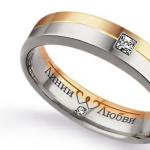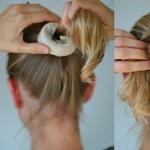Temporary dreadlocks at home. Methods for weaving dreadlocks
You can stand out from the gray crowd with the help of dreadlocks. An alarming number of young people think so. Having scanned how much it costs to get dreadlocks done by a famous craftsman-master of weaving, most decide on the most serious scam of their lives - creating a similar hairstyle at home, economically. To complete this super fantastic mission you will need a ton of patience and at least one loyal friend.
How to weave dreadlocks? There are quite a few ways to do this within the walls of your home. But, of course, there is only one optimal option. After fulfilling the simple, but labor-intensive requirements, the dreadlocks will take on the necessary tousled appearance and will delight the immediate teenage environment.
Wax for work
How to make dreadlocks? Many masters do not talk much about the tricks and principles of their painstaking work. The main character of the entire campaign will be high-quality wax for dreadlocks. Many people relegate it to the background, considering it a finishing product for caring for a finished hairstyle. In fact, beeswax plays the most central role - a lot depends on the quality of the product: the purity, structure and gloss of each dreadlock. By applying it evenly to each braid, a person not only maintains fixation, but also takes care of the condition of the hair.

Other items to work with
Small, comfortable elastic bands, clips, and a thick, large comb will also help you braid dreadlocks. These items must be selected carefully. You should not choose elastic bands that are too tight and dense; their pressure will significantly damage your hair and make it difficult to use. It is better to choose durable clamps without any decorative elements or additional parts; this will significantly reduce the procedure time. You need to find a high-quality comb with a comfortable handle; its too streamlined shape is not entirely comfortable during weaving.
Wash your hair correctly
It is better to weave dreadlocks at home in the company of like-minded people, so the time will be spent productively, and weaving in an inaccessible area will be much easier. To begin with, you should wash your hair thoroughly and dry it gently. You can only apply a light conditioner to your curls. Balms and especially oils with their greasy texture are strictly prohibited.
Preparatory stage of work

How to weave dreadlocks with your own hands? To begin with, you should slowly distribute the entire mop into small squares (1.5-2 cm on each side). The finished braid will be voluminous and rather clumsy, this should be taken into account before weaving, then the dimensions of the broken squares will be more clear.
During the formation of each section, it is necessary to follow the rules of distribution of the checkerboard, so that the surface of the head will be evenly filled with dreadlocks and bald spots will not appear. Another important nuance is the direction of weaving: it’s easier to start on the back of the head, and finish on the forehead. It is this technique that allows you to correct the process at all time intervals. Each selected strand must be restrained with an elastic band strictly at the roots; no hairs or shortened strands can be knocked out. It is the rubber bands that will help you unravel dreadlocks in the future, because thanks to them there is a clear limitation of each braid.
Weaving wonderful braids

The principle of weaving is quite harmless: each braid goes through a process of backcombing from the roots to the very ends, as well as revolutions around its own axis. The first thing to identify is the lower strands: the process of “filling your hands” is more convenient on them, and the hands themselves do not get so tired from constant tension. The longest braids are often obtained at the back of the head, while the top of the head is decorated with short dreadlocks.
Before combing, each strip of hair is freed from being captured by an elastic band and combed until a dense, persistent hairball is formed. When its structure becomes satisfactory, the comb can be moved down the hair. After the backcombing is completed, the dreadlocks must be secured at the roots and at the tip with an elastic band so that when working with adjacent strands the integrity of the already finished strands is not compromised. The lower clamp cannot be removed for the next 2-3 weeks, so that the dreadlocks that have not yet matured do not fall apart.
Important Principles

When making dreadlocks at home, it’s worth remembering a few tricks for weaving them:
- each braid must be moistened with beeswax, so clean hair will strengthen its safety against dirt;
- To make the wax easy to use, you need to knead it well in your palms;
- the first layer of product should be large, otherwise all efforts are in vain (lack of wax will cause destruction of the backcomb under the influence of external factors, hair contamination and even lice);
- For the required degree of impregnation with wax, you can use a hairdryer; it will help droplets of the product penetrate deep into the braid and remain there after the procedure is completed.
As a result of the work done, your head will be decorated with 30-40 excellent and durable braids. A similar technique of weaving dreadlocks is applicable on hair longer than 10-12 cm; shorter hairs will capriciously fall out of the comb. It is quite difficult to unravel short dreadlocks; the hairs were twisted too zealously during combing. Therefore, only scissors can untie such a lump.
Before making dreadlocks, it is worth remembering the troubles that will await you after undoing your braids. After such a hairstyle, up to 50 percent of the hair is lost, and the remaining hair “heroes” require enormous restoration procedures. Wax, although it gives the curls minimal care, still does not compensate for the lack of cleanliness and other means of moisturizing.
We sort out dreadlocks correctly
Now let's look at how the procedure for parsing such structures occurs. Detangling wax-soaked hair will require the use of a fork or a sturdy metal crochet hook. To simplify the combing process, dreadlocks can be moistened with hot water (do not just use warm water). The wax must be moved from its established location on the strands. Therefore, it is necessary to use hot water.
Care in the first month
Having figured out how to make dreadlocks, it is worth knowing the specific care technique. In the first month, braids cannot be subjected to water procedures, as this will negatively affect their fragile structure. But during this period, itching may appear, which only a steep chamomile decoction will help get rid of. They need to slowly and fairly carefully treat the skin, avoiding scratching or damaging the skin.
Subsequent washing

After a waterless month, the dreadlocks can be washed using soap or high-quality tar shampoo. The procedure is carried out slowly, each braid must be carefully treated with water and detergent. Do not rub the strand too hard; once it gets wet, it may become unraveled. Also, many admirers of this hairstyle recommend washing your braids in a decoction of not very hot hibiscus tea and a half-spoon of ground cinnamon. Also, most note the positive effect of ash as a dry shampoo. They save dreadlock fans in the first month.

Hair adjustment
Corrective manipulations to restore the density of the dreadlock structure must be carried out at least once every 4 weeks, so the strands will have the best possible well-groomed appearance for this hairstyle, and you also need to constantly monitor the fixation of each braid.

A little conclusion
Now you know how to make dreadlocks at home. Before you decide to recreate something like this on your hair, it’s worth weighing all the pros and cons so that, in addition to the complex braiding procedure, you don’t add the frustration of systematically caring for unusual braids and unraveling them. To simplify the thinking process, you should surround yourself with photos of hairstyles you’ve already done; this way of visualizing your own dream will help you understand the full extent of its importance.
In winter and autumn, gray, joyless everyday life outside the window. It makes me want to color them and add a little fun to them. Perhaps it's time to make a radical change and braid dreadlocks? This exotic hairstyle is increasingly seen on the streets. In order to build it on your head, you can trust a professional craftsman, or you can try to do it yourself.
Dreadlocks are artificially tangled strands that should be as close in appearance as possible to their natural, careless appearance. Most often, this hairstyle is associated with people from Jamaica who profess Rastafarianism. Many people consider dreadlocks to be a kind of antenna for drawing cosmic energy. If you decide to get dreadlocks, think very carefully. Firstly, this is a fairly long process that will take more than one day. Secondly, this is a traumatic process for the hair, and in order to return your original hairstyle, you may have to lose your chic curls and cut your hair very short.







There are several other ways to weave dreadlocks, each with its own disadvantages and a number of advantages. If you decide on such an extravagant hairstyle, be sure to consult a professional!
Dreadlocks are one of the most original and extreme hairstyles, which gains new fans every year. Until recently, this hairstyle was popular in youth subcultures, today it is becoming popular outside of teenage movements. Weaving dreadlocks requires special skills and, of course, experience. Therefore, before you start experimenting with your look, you should familiarize yourself in more detail with the technology for creating this exotic hairstyle.
Dreadlocks: how to make it yourself?
Dreadlock weaving technology
There is a huge selection of methods for braiding dreadlocks, but each of them requires practical skills, especially braiding on short and thin hair. Therefore, before you start creating a new exotic look, you should first get your hands on artificial materials such as wool or Kanekalon, or attend several master classes on weaving dreadlocks.
Once you have mastered these basic skills, start preparing. First, pay attention to your hair type. After all, dyed and weak hair will not be able to withstand heavy loads when braiding it, so most methods of creating dreadlocks are prohibited for them.
Therefore, first, consult with a specialist and strengthen your hair with the help of medicinal and restorative products
Measure the length of your hair. It should not be shorter than 15 cm, since in the final form the hair becomes a third shorter. Of course, professionals can braid dreadlocks up to 5–7 cm, but for a beginner dreadlocker this will not be possible. If your hair is short, but you really want to do this hairstyle, you can lengthen your dreadlocks using felt or kanekalon, wool or natural hair will also work.
It should be borne in mind that when wet, wool emits a very unpleasant odor, and natural hair can cause allergies.
Decide on the number and thickness of dreadlocks. The best option is 25–50 dreadlocks. The more pieces you have on your head, the thinner they will be, and vice versa. Remember: if you have too many dreadlocks, maintaining them will be twice as difficult. And if you are lazy and braid less, your hairstyle will look unfinished.
The day before braiding, you should wash your hair with soap or natural shampoo without using conditioners or masks. It is very important that the hair is not obedient, smooth and, most importantly, tangles well.
Mark your head in a checkerboard pattern, dividing the strands into segments and securing them with elastic bands at the very roots
Think in advance about what the ends of your dreadlocks should be. There are two options: you can leave your natural hair, thereby creating the effect of a “living tip,” or simply weave in artificial hair. To do this, divide the tip into thin strands and use a hook to weave them into a dreadlock.
This weaving will strongly resemble “stitches”. Don't make them very huge and don't weave them very far from the place from which they will peek out. The ideal option would be to weave the strands very close together. If you are slightly in doubt and are afraid to experiment with real hair, you can do it “safely”. In other words, these are ready-made dreadlocks that are easily attached to your hair and can be worn for 3-4 months.
Ways to weave dreadlocks at home
There is a huge selection of ways to create dreadlocks, the most common are:
- weaving
- bouffant
- twisting
- synthetic dreadlocks
Braiding is done on natural strands of 8 cm in length. Divide the hair into perfectly even sections, then take one of the strands (it is better to start with the bangs), twist it like a rope and sharply divide it into two parts. If the division is successful, you will hear the hair cracking. Next, divide one of the parts into two again.
After this, make 1 braided twist and start again until all the strands are finished. You can tuck any stray hairs into a dreadlock or cut them off. Secure the ends of the dreadlocks with wax. Required material for weaving: special comb, hook or knitting needle, wax.
Combing is one of the fastest methods, because immediately after combing the desired effect is achieved. To do this, you need, as in all other methods, to divide the scalp into even sectors in the shape of squares. Secure the resulting strands with elastic bands at the roots of your hair. After this, using an iron comb or a special comb, begin combing your hair in the opposite direction.
If you don't have a suitable comb, you can comb it by hand
After you have rolled the strands to a knotted state, begin weaving, lowering the resulting clumps of hair down to the roots. Try to comb to the end of the hair so that the dreadlock looks as dense as possible. Using a good wax and soap will help keep your hair in place. This method is good because the effect is visible immediately, but to get optimal results you will need 3-4 months of careful dreadlock care. Necessary material for backcombing: a special comb (comb), a hook, rubber bands to secure the roots of dreadlocks, wax.
Twisting. Divide your head into even squares. For convenience, put rubber bands on the strands. After this, start twisting the strands clockwise, tangling them with a comb. To fix twisted strands, use special wax for dreadlocks without petroleum.
To maintain the shape of the hairstyle, it is necessary to systematically roll the dreadlocks by hand over several months.
A girl with dreadlocks on her head is a clear pendulum that everyone without exception notices. This hairstyle allows you to stand out from the crowd and emphasize your individuality. It came to us from antiquity and still remains at the peak of popularity among young people. In addition to being spectacular, sealed strands save owners from tedious styling and careful care, because most often they do not unravel, and are subsequently simply cut off. However, there are safe dreadlocks that have virtually no effect on hair health and can be easily removed.

Creating a bright hairstyle at home
Everyone has a rough idea of how dreadlocks are made in a hair salon. But not every young lady has the required amount of money, especially considering the fact that parents are unlikely to sponsor this radical method of becoming bright. Stylists tracking what happens to curls after wearing tight strands for a long time have developed safe dreadlocks made from artificial materials that are woven into the natural strands. They can be purchased at a specialized salon and attached to your hair. But first things first…

Option 1 – Ready-made dreadlocks
How to make dreadlocks when woven pieces have already been purchased?

Prepare the necessary materials:
- shampoo;
- elastic bands in the color of your native curls;
- wax;
- threads to match the hair color;
- long needle with a wide eye;
- 40 -60 blanks from Kanekalon.

In addition, you will need the help of a friend or sister, perhaps your hairdresser. One end of the finished product is sealed, and the other has loose artificial hairs about fifteen centimeters long. We will work with them. Weaving dreadlocks occurs as follows:

With this method of creating a hairstyle, you can cut short the hair growing below the line running from the middle of one to the middle of the second ear.

Option 2 – Artificial Dreadlocks
Safe dreadlocks can be created by weaving artificial hair. To create a hairstyle, you will need the same accessories as in the first option, except for artificial dreadlocks. The length of the purchased material must exceed the length of the desired hairstyle by three times.

This installation can be done without outside help. It is done simply:

As you can see, this method is absolutely safe, since your own hair is protected by artificial hair.
For young and perky ladies, we suggest using colored threads instead of artificial hair. Firstly, it is more accessible and cheaper, and secondly, you can get the most incredible color schemes.


Option 3 – Dreadlocks from your own hair
This method is intended for those who want to learn how to weave dreadlocks from their own hair. There are different techniques that minimally destroy the structure of the hairs.

You can make harmless dreadlocks at home like this:
- Divide your hair into squares about two centimeters square and secure each with an elastic band.
- Release the first piece and create a tight braid from it, leaving no loose ends.
- Secure the roots and ends with invisible rubber bands.
- Cover the braid with wax and roll it between your palms for a long time to seal it.
- Do this procedure with each workpiece.
Those with sparse or thin hair can cheat and get thicker braids if the braids are folded in half and then secured with elastic bands at the roots and ends.

Dreadlocks have been in fashion for a long time. Their relevance increases every time the weather warms up. As soon as the sun starts to get hot, we want to experiment with our hair again. Many are eager to try on ancient, pre-civilization motifs, which give the overall style a bold, youthful chic.
You will need:
- Artificial dreadlocks;
- Comb;
- Hair clips.
If you have so far only looked at photos of dreadlocks, not daring to make a bold experiment, perhaps after this article you will dare to radically change your image. We will tell you in detail how to make dreadlocks.
Safe dreadlocks are special decorations for the head. They do not harm the hair. There is no need to tangle your hair; prepared strands of artificial material - kanekalon or felt - can easily be woven into it. The master hairdresser, using a certain technology, folds the cords and attaches them to the hair. This hairstyle will easily last about 3-4 months. Afterwards you can easily remove the extensions.
The so-called dreadlocks are also relevant today. They are ready-made cords manufactured at the factory.
Step by step
If you decide to weave dreadlocks at home, we suggest you read the instructions.
- First you need to thoroughly wash your hair and dry it. Do not use balm.
- Then comb your hair thoroughly.
- Divide the entire head into square sections. You should get the same amount of hair everywhere. Clamp each strand with special clips. It’s better to start from the back of the head, gradually moving towards the forehead, and then treat the lower part of the head.
- You can choose the size of each square at your discretion. As a rule, shapes measuring 1.5 by 1.5 cm are formed.
- It is recommended to arrange them in a checkerboard pattern. Then there will be no unaesthetic bald spots.
- Take a safe dreadlock or ja dreadlock and weave it in. Typically, artificial ropes are folded in half and secured with a very tight braid, as shown in the video.
www.youtube.com/watch?v=hN7CRLGI80o
Such manipulations are possible on strands from 5 to 15 cm. If the hair is longer, you risk subsequently being left without part of the hair due to the fact that it will not be easy to unravel the creation.
Making dreadlocks at home needs to be done with extreme caution. Start from the bottom of your head. You will have to be patient; the work will take at least several hours.




